Guitar picks, or plectrums, might seem like a small and insignificant piece of gear, but for guitarists, they are a crucial extension of our hands and a key component in shaping our sound. Just like many guitarists, you might have gone through a box full of different picks before landing on your favorite. From experimenting with various materials, thicknesses, and shapes, the quest for the “perfect pick” is a journey many of us undertake. Perhaps you’ve tried everything from thin, flexible picks for strumming to thicker, rigid ones for fast picking, or maybe even novelty rubber picks just for fun.
But have you ever considered focusing your search on a brand synonymous with guitar excellence – Fender? Fender Guitar Plectrums are more than just accessories; they are crafted with a legacy of understanding guitarists’ needs. This guide dives deep into the world of Fender picks, exploring why they are so highly regarded and how to choose the best Fender plectrum to elevate your playing.
 Fender guitar picks of various colors and thicknesses
Fender guitar picks of various colors and thicknesses
Why Are Guitarists So Picky About Picks? (Especially Fender Users!)
Let’s face it, guitarists are detail-oriented, and perhaps a little picky, about every aspect of their gear. From the gauge and brand of strings (even if many are made by the same manufacturer!) to tuners, fret material, and everything in between, options abound, and preferences run deep. But this pickiness is born from a genuine desire to optimize our tone and playing experience. Everything we use is a tool, and the pick is a particularly intimate one. It’s the direct interface between us and our instrument, enabling us to articulate the riffs, licks, and chords that fuel our musical expression.
If you’re the type to experiment with different sounds and setups, you probably understand the allure of having multiple pedals and gear variations. And when it comes to guitar picks, especially affordable options from brands like Fender, the exploration is part of the fun. It’s worth grabbing a variety pack of Fender plectrums to truly discover what feels and sounds best in your hands.
What Materials Are Fender Guitar Picks Made From?
Fender offers a diverse range of guitar picks made from various materials, each influencing the tone, feel, and durability. Understanding these materials is key to choosing the right Fender plectrum for your needs.
Celluloid: The Classic Fender Foundation
Celluloid is the iconic material behind the classic “tortoise shell” Fender picks. It’s known for producing a bright, snappy tone, which is a signature characteristic of many Fender guitars. Fender celluloid picks are a staple for players seeking that vintage Fender sound and feel.
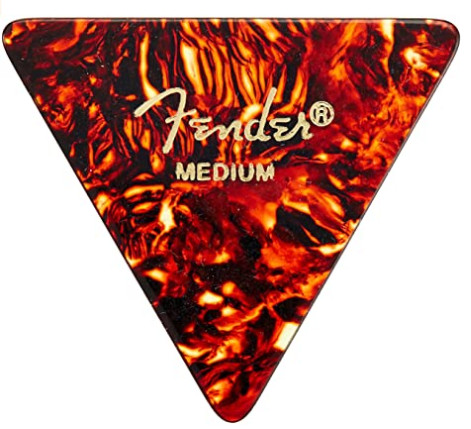 Fender celluloid guitar picks in tortoise shell design
Fender celluloid guitar picks in tortoise shell design
Nylon: Grip and Warmth from Fender
Fender nylon picks, similar to Dunlop Standard Picks in their broad appeal, are favored for their unique grip texture and warmer tonal qualities. The slightly textured surface provides excellent control, especially for players who tend to have sweaty hands. Nylon Fender picks offer a different sonic palette compared to celluloid, leaning towards a smoother, less bright sound.
Acetal (Tortex): Durability and Enhanced Grip in Fender Style
While “Tortex” is a Dunlop brand name, the material itself – acetal – is also used by Fender in some of their pick lines, often marketed under different names but with similar properties. Acetal picks, especially those with a matte or powdered grip enhancement, are loved for their durability and comfortable feel. This material strikes a balance between brightness and warmth and is known for its longevity, meaning your Fender acetal picks will last through many gigs and practice sessions.
Other Materials in Fender’s Range
While celluloid, nylon, and acetal are prominent, Fender also experiments with other materials to cater to diverse player preferences. These might include:
- Ultem: Offering stiffness and a bright tone, similar to other Ultem picks on the market.
- Acrylic: Providing clarity, density, and durability, often with textured grips to compensate for the slickness of the material.
Exploring Fender Pick Shapes and Sizes for Your Playing Style
Beyond material, the shape and thickness of your Fender guitar pick significantly impact your playing experience and sound. Fender offers a variety of shapes and gauges to suit different styles and techniques.
Fender Classic/Standard Pick Shape: The 351
The “Classic” or “Standard” shape, often referred to as the 351 shape, is perhaps the most recognizable and widely used guitar pick shape, and Fender’s rendition is a benchmark. It’s designed to fit comfortably between your thumb and index finger, offering versatility for various playing styles. You can adjust your grip on a Fender 351 pick to achieve different levels of control and attack.
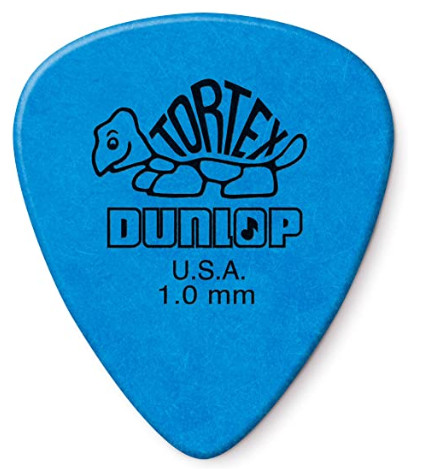 Fender classic shape guitar pick
Fender classic shape guitar pick
Fender Jazz Picks: Precision and Articulation
Fender Jazz picks, mirroring the popular Jazz pick style, are smaller and often have a sharper point compared to standard picks. While the name suggests jazz, they are incredibly popular among metal and rock players seeking maximum picking accuracy and articulation. The smaller size of Fender Jazz picks encourages precise picking and fast runs.
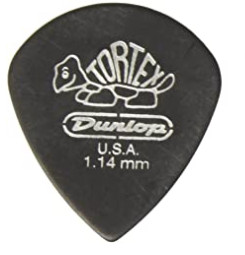 Fender Jazz style guitar pick
Fender Jazz style guitar pick
Fender Triangle Picks: Enhanced Grip and Versatility
If you find standard or jazz picks too small, Fender triangle picks, or tri-tip picks, offer a larger surface area for a more substantial grip. This shape can be particularly comfortable for players with larger hands or those who prefer a more secure hold. The three points also offer varied playing edges, extending the pick’s lifespan.
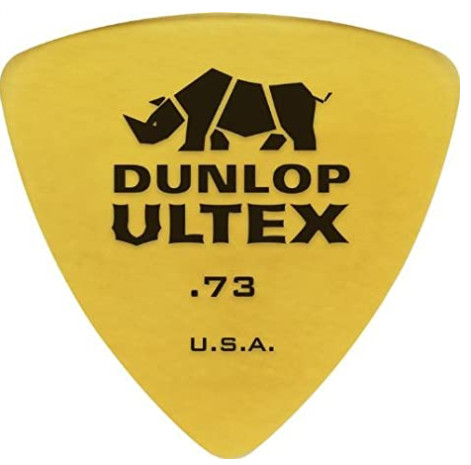 Fender triangle guitar pick
Fender triangle guitar pick
Fender Pick Sizes (Thickness): Fine-Tuning Your Tone
Fender, like other pick manufacturers, categorizes pick thickness into general ranges:
- Thin (Light): Around .40mm to .60mm. Thinner Fender picks are excellent for strumming and producing a brighter, less bass-heavy tone. They are favored by acoustic guitarists and players who want a lighter touch.
- Medium: .60mm to .80mm. Medium Fender picks offer a balance of flexibility and stiffness, suitable for both strumming and some lead work. They provide a fuller tone than thin picks.
- Heavy: .80mm to 1.20mm. Heavy Fender picks are favored by rock, blues, and metal players for their ability to deliver a powerful, full-bodied tone and increased control for lead playing.
- Extra Heavy: Above 1.20mm. Extra heavy Fender picks offer maximum stiffness and are ideal for aggressive styles, heavy riffing, and players who demand the most control and thickest possible tone.
The thicker the Fender pick, the more energy it transfers to the strings, resulting in a richer, more resonant sound, especially noticeable on electric guitars. Thinner picks are more flexible, producing a brighter, snappier attack, often preferred for acoustic strumming.
Choosing the Right Fender Plectrum for Different Styles and Needs
Fender offers picks designed to excel in various playing scenarios. Here’s a guide to help you choose:
Best Fender Picks for Shredding and Lead Guitar
For fast, articulate lead playing, especially “shredding,” you’ll want a firmer Fender pick that’s not excessively thick. Look for Fender picks in the .80mm to 1.00mm range, often in Jazz or standard shapes for point accuracy. Many lead players prefer Fender Tortoise Shell picks in medium-heavy gauges or Fender Moto picks for a slicker feel.
Best Fender Picks for Acoustic Guitar Strumming
For acoustic guitar strumming, especially if you play mostly chords, a wider range of Fender picks can work. If you’re a heavy strummer, stick to medium gauges (around .70mm-.80mm) to avoid muddiness. Lighter strummers can explore thinner Fender picks (.60mm and below) for a brighter, janglier sound. Fender celluloid picks in thin and medium are classic choices for acoustic strumming.
Fender Picks for Players with Joint Pain or Arthritis
For players experiencing wrist pain or arthritis, ergonomic Fender picks can make a difference. Larger picks, like Fender triangle picks, are easier to grip and require less pressure. While Fender doesn’t specifically market “ergonomic” picks, their larger triangle shapes or even thicker picks can be more comfortable.
Fender Picks with Enhanced Grip
If you struggle with dropping picks, Fender offers textured picks to improve grip. Look for Fender picks with grip-enhancing surfaces. While Fender doesn’t heavily emphasize textured grips as a primary feature across all lines, some of their nylon or specially coated picks offer a naturally enhanced grip.
The Iconic Fender Celluloid Pick: A Deeper Dive
No discussion of Fender plectrums is complete without highlighting the iconic Fender celluloid pick. These picks are more than just functional tools; they are a piece of Fender history and a part of the brand’s sonic identity.
Fender celluloid picks are celebrated for:
- Classic Fender Tone: The celluloid material contributes to the bright, articulate tone that complements Fender guitars beautifully, especially Strats and Teles.
- Vintage Feel: Many players appreciate the slightly softer feel of celluloid compared to more modern materials, offering a comfortable and familiar playing experience.
- Variety of Colors and Swirls: Fender celluloid picks come in a wide array of colors and the classic “tortoise shell” patterns, adding a touch of visual flair to your playing.
- Affordability and Accessibility: Fender celluloid picks are widely available and reasonably priced, making them a staple for guitarists of all levels.
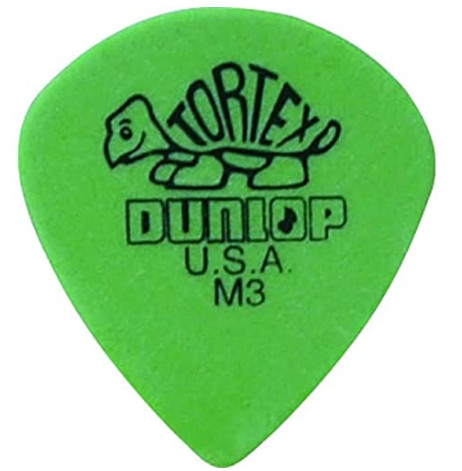 Variety of Fender celluloid guitar picks close up
Variety of Fender celluloid guitar picks close up
Experiment and Find Your Fender Pick Perfection
The best way to discover your perfect Fender guitar plectrum is through experimentation. Fender picks are readily available and affordable, making it easy to build a collection and try different types.
Here’s how to approach your Fender pick exploration:
- Get a Variety Pack: Fender offers variety packs that include different materials, shapes, and thicknesses. This is an excellent starting point to sample a range of options.
- Trial Period: Give each Fender pick you try a fair trial – a week of playing or more, depending on your practice frequency. This allows you to adjust to the feel and hear how it affects your tone in different playing situations.
- Consider Your Guitars: Try different Fender picks with both your electric and acoustic guitars. You might find that you prefer different picks for each instrument, just as many players do.
- Don’t Be Afraid to “NOPE!”: Some picks you try might immediately feel wrong. That’s okay! Even “bad” experiences help you narrow down your preferences.
- Seek Inspiration: Switching to a Fender pick that’s different from your usual choice can spark new creative ideas and approaches to your playing.
Just like experimenting with different pedals or guitar settings, exploring Fender guitar plectrums is a rewarding part of the guitarist’s journey. You might just find that the perfect pick to unlock your best playing is waiting within the vast and varied world of Fender plectrums. So grab a few different Fender picks, plug in, and start exploring!
